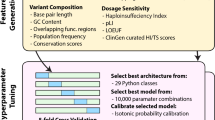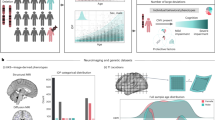Abstract
The widespread clinical utilization of array comparative genome hybridization, has led to the unraveling of many new copy number variations (CNVs). Although some of these CNVs are clearly pathogenic, the phenotypic consequences of others, such as those in 16p13.11 remain unclear. Whereas deletions of 16p13.11 have been associated with multiple congenital anomalies, the relevance of duplications of the region is still being debated. We report detailed clinical and molecular characterization of 10 patients with duplication and 4 patients with deletion of 16p13.11. We found that patients with duplication of the region have varied clinical features including behavioral abnormalities, cognitive impairment, congenital heart defects and skeletal manifestations, such as hypermobility, craniosynostosis and polydactyly. These features were incompletely penetrant. Patients with deletion of the region presented with microcephaly, developmental delay and behavioral abnormalities as previously described. The CNVs were of varying sizes and were likely mediated by non-allelic homologous recombination between low copy repeats. Our findings expand the repertoire of clinical features observed in patients with CNV in 16p13.11 and strengthen the hypothesis that this is a dosage sensitive region with clinical relevance.
Similar content being viewed by others

Log in or create a free account to read this content
Gain free access to this article, as well as selected content from this journal and more on nature.com
or
References
Sebat J, Lakshmi B, Troge J et al: Large-scale copy number polymorphism in the human genome. Science 2004; 305: 525–528.
Iafrate AJ, Feuk L, Rivera MN et al: Detection of large-scale variation in the human genome. Nat Genet 2004; 36: 949–951.
Koolen DA, Vissers LE, Pfundt R et al: A new chromosome 17q21.31 microdeletion syndrome associated with a common inversion polymorphism. Nat Genet 2006; 38: 999–1001.
Ballif BC, Hornor SA, Jenkins E et al: Discovery of a previously unrecognized microdeletion syndrome of 16p11.2-p12.2. Nat Genet 2007; 39: 1071–1073.
Sharp AJ, Selzer RR, Veltman JA et al: Characterization of a recurrent 15q24 microdeletion syndrome. Hum Mol Genet 2007; 16: 567–572.
Shaw-Smith C, Pittman AM, Willatt L et al: Microdeletion encompassing MAPT at chromosome 17q21.3 is associated with developmental delay and learning disability. Nat Genet 2006; 38: 1032–1037.
Nagamani SC, Zhang F, Shchelochkov OA et al: Microdeletions including YWHAE in the Miller-Dieker syndrome region on chromosome 17p13.3 result in facial dysmorphisms, growth restriction, and cognitive impairment. J Med Genet 2009; 46: 825–833.
Nagamani SC, Erez A, Shen J et al: Clinical spectrum associated with recurrent genomic rearrangements in chromosome 17q12. Eur J Hum Genet 2010; 18: 278–284.
Shinawi M, Liu P, Kang SH et al: Recurrent reciprocal 16p11.2 rearrangements associated with global developmental delay, behavioral problems, dysmorphism, epilepsy, and abnormal head size. J Med Genet 2010; 47: 332–341.
Sharp AJ, Hansen S, Selzer RR et al: Discovery of previously unidentified genomic disorders from the duplication architecture of the human genome. Nat Genet 2006; 38: 1038–1042.
Mefford HC, Sharp AJ, Baker C et al: Recurrent rearrangements of chromosome 1q21.1 and variable pediatric phenotypes. N Engl J Med 2008; 359: 1685–1699.
Brunetti-Pierri N, Berg JS, Scaglia F et al: Recurrent reciprocal 1q21.1 deletions and duplications associated with microcephaly or macrocephaly and developmental and behavioral abnormalities. Nat Genet 2008; 40: 1466–1471.
van Bon BW, Mefford HC, Menten B et al: Further delineation of the 15q13 microdeletion and duplication syndromes: a clinical spectrum varying from non-pathogenic to a severe outcome. J Med Genet 2009; 46: 511–523.
Hannes FD, Sharp AJ, Mefford HC et al: Recurrent reciprocal deletions and duplications of 16p13.11: the deletion is a risk factor for MR/MCA while the duplication may be a rare benign variant. J Med Genet 2009; 46: 223–232.
Loftus BJ, Kim UJ, Sneddon VP et al: Genome duplications and other features in 12 Mb of DNA sequence from human chromosome 16p and 16q. Genomics 1999; 60: 295–308.
Martin J, Han C, Gordon LA et al: The sequence and analysis of duplication-rich human chromosome 16. Nature 2004; 432: 988–994.
Ullmann R, Turner G, Kirchhoff M et al: Array CGH identifies reciprocal 16p13.1 duplications and deletions that predispose to autism and/or mental retardation. Hum Mutat 2007; 28: 674–682.
de Kovel CG, Trucks H, Helbig I et al: Recurrent microdeletions at 15q11.2 and 16p13.11 predispose to idiopathic generalized epilepsies. Brain 2010; 133: 23–32.
Heinzen EL, Radtke RA, Urban TJ et al: Rare deletions at 16p13.11 predispose to a diverse spectrum of sporadic epilepsy syndromes. Am J Hum Genet 2010; 86: 707–718.
Mefford HC, Muhle H, Ostertag P et al: Genome-wide copy number variation in epilepsy: novel susceptibility loci in idiopathic generalized and focal epilepsies. PLoS Genet 2010; 6: e1000962.
Mefford HC, Cooper GM, Zerr T et al: A method for rapid, targeted CNV genotyping identifies rare variants associated with neurocognitive disease. Genome Res 2009; 19: 1579–1585.
Kriek M, White SJ, Szuhai K et al: Copy number variation in regions flanked (or unflanked) by duplicons among patients with developmental delay and/or congenital malformations; detection of reciprocal and partial Williams-Beuren duplications. Eur J Hum Genet 2006; 14: 180–189.
Ingason A, Rujescu D, Cichon S et al: Copy number variations of chromosome 16p13.1 region associated with schizophrenia. Mol Psychiatry 2009, e-pub ahead of print 29 September 2009; doi:10.1038/mp.2009.101.
Kirov G, Grozeva D, Norton N et al: Support for the involvement of large copy number variants in the pathogenesis of schizophrenia. Hum Mol Genet 2009; 18: 1497–1503.
Bi W, Sapir T, Shchelochkov OA et al: Increased LIS1 expression affects human and mouse brain development. Nat Genet 2009; 41: 168–177.
El-Hattab AW, Smolarek TA, Walker ME et al: Redefined genomic architecture in 15q24 directed by patient deletion/duplication breakpoint mapping. Hum Genet 2009; 126: 589–602.
Probst FJ, Roeder ER, Enciso VB et al: Chromosomal microarray analysis (CMA) detects a large X chromosome deletion including FMR1, FMR2, and IDS in a female patient with mental retardation. Am J Med Genet A 2007; 143A: 1358–1365.
Amos-Landgraf JM, Ji Y, Gottlieb W et al: Chromosome breakage in the Prader-Willi and Angelman syndromes involves recombination between large, transcribed repeats at proximal and distal breakpoints. Am J Hum Genet 1999; 65: 370–386.
Shaw CJ, Withers MA, Lupski JR : Uncommon deletions of the Smith-Magenis syndrome region can be recurrent when alternate low-copy repeats act as homologous recombination substrates. Am J Hum Genet 2004; 75: 75–81.
Ikeda M, Aleksic B, Kirov G et al: Copy number variation in schizophrenia in the Japanese population. Biol Psychiatry 2010; 67: 283–286.
Feng Y, Walsh CA : Mitotic spindle regulation by Nde1 controls cerebral cortical size. Neuron 2004; 44: 279–293.
Kwon YT, Balogh SA, Davydov IV et al: Altered activity, social behavior, and spatial memory in mice lacking the NTAN1p amidase and the asparagine branch of the N-end rule pathway. Mol Cell Biol 2000; 20: 4135–4148.
Ramocki MB, Zoghbi HY : Failure of neuronal homeostasis results in common neuropsychiatric phenotypes. Nature 2008; 455: 912–918.
Girirajan S, Rosenfeld JA, Cooper GM et al: A recurrent 16p12.1 microdeletion supports a two-hit model for severe developmental delay. Nat Genet 2010; 42: 203–209.
Acknowledgements
We thank the participating families for their kind cooperation. This work was supported in part by fellowship grants by the LCRC from Osteogenesis Imperfecta Foundation (SNSC), DK081735-01A1, NIH/NIGMS T32 contract grant number GM07526 (AE). We thank Pengfei Lui for his input on the mechanism of rearrangement.
Author information
Authors and Affiliations
Corresponding author
Ethics declarations
Competing interests
The authors declare no conflict of interest.
Rights and permissions
About this article
Cite this article
Nagamani, S., Erez, A., Bader, P. et al. Phenotypic manifestations of copy number variation in chromosome 16p13.11. Eur J Hum Genet 19, 280–286 (2011). https://doi.org/10.1038/ejhg.2010.184
Received:
Revised:
Accepted:
Published:
Issue date:
DOI: https://doi.org/10.1038/ejhg.2010.184
Keywords
This article is cited by
-
Clinical exome sequencing efficacy and phenotypic expansions involving anomalous pulmonary venous return
European Journal of Human Genetics (2023)
-
16p13.11 microdeletion/microduplication in fetuses: investigation of associated ultrasound phenotypes, genetic anomalies, and pregnancy outcome follow-up
BMC Pregnancy and Childbirth (2022)
-
Prevalence of copy number variants (CNVs) and rhGH treatment efficacy in an Italian cohort of children born small for gestational age (SGA) with persistent short stature associated with a complex clinical phenotype
Journal of Endocrinological Investigation (2022)
-
High-resolution chromosomal microarray analysis for copy-number variations in high-functioning autism reveals large aberration typical for intellectual disability
Journal of Neural Transmission (2020)
-
NDE1 and NDEL1 from genes to (mal)functions: parallel but distinct roles impacting on neurodevelopmental disorders and psychiatric illness
Cellular and Molecular Life Sciences (2017)


